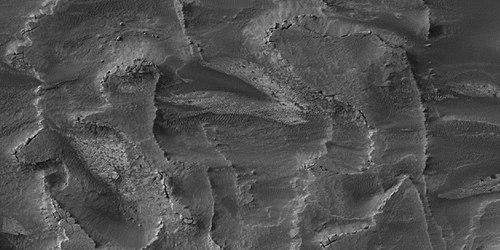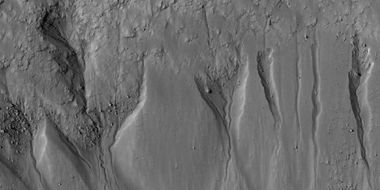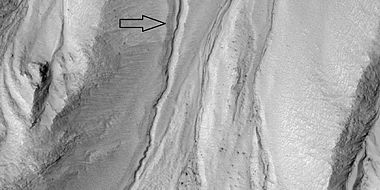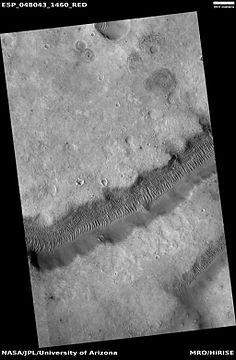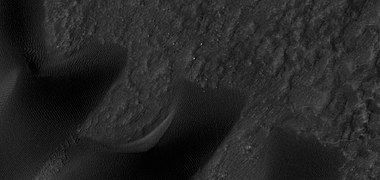Difference between revisions of "Argyre quadrangle"
m |
m |
||
| Line 34: | Line 34: | ||
<gallery class="center" widths="380px" heights="360px"> | <gallery class="center" widths="380px" heights="360px"> | ||
| − | |||
ESP 046684 1280molawide.jpg|Wide view of area around Galle Crater Colors show elevations. | ESP 046684 1280molawide.jpg|Wide view of area around Galle Crater Colors show elevations. | ||
| Line 62: | Line 61: | ||
==[[Martian gullies]]== | ==[[Martian gullies]]== | ||
| − | [[File: ESP 040974 1395gullies.jpg|thumb|500px|center|Wide view of gullies in Arkhangelsky Crater, as seen by HiRISE under[[HiWish program]]]] | + | [[File: ESP 040974 1395gullies.jpg|thumb|500px|center|Wide view of gullies in Arkhangelsky Crater, as seen by HiRISE under [[HiWish program]]]] |
| − | Gullies are common in some latitude bands on Mars—usually in midlatitudes. Most Martian gullies are found on the walls of craters or troughs, but Charitum Montes, a group of mountains, has gullies in some | + | Gullies are common in some latitude bands on Mars—usually in midlatitudes. Most Martian gullies are found on the walls of craters or troughs, but Charitum Montes, a group of mountains, has gullies in some locations. |
Gullies occur on steep slopes, especially on the walls of craters. Gullies are believed to be relatively young because they have few, if any craters. Moreover, they sometimes are on top of sand dunes which themselves are considered to be quite young. Usually, each gully has an alcove, channel, and apron. For many years, researchers thought the gullies were made by running water. But after many more observations it was found that gullies are being formed today which cannot happen with liquid water. <ref>Dundas, C., S. | Gullies occur on steep slopes, especially on the walls of craters. Gullies are believed to be relatively young because they have few, if any craters. Moreover, they sometimes are on top of sand dunes which themselves are considered to be quite young. Usually, each gully has an alcove, channel, and apron. For many years, researchers thought the gullies were made by running water. But after many more observations it was found that gullies are being formed today which cannot happen with liquid water. <ref>Dundas, C., S. | ||
| − | Diniega, and A. McEwen. 2014. LONG-TERM MONITORING OF MARTIAN GULLY ACTIVITY WITH HIRISE. 45th Lunar and Planetary Science Conference. 2204.pdf</ref> <ref>NASA/Jet Propulsion Laboratory. "NASA orbiter finds new gully channel on Mars." ScienceDaily. ScienceDaily, 22 March 2014. www.sciencedaily.com/releases/2014/03/140322094409.htm </ref> The weather conditions on present day Mars are such that sufficient liquid water cannot exist to cause gullies to form. Experiments on the Earth showed that gullies can be made with the movement of chunks of dry ice moving down steep slope. <ref>http://spaceref.com/mars/frosty-gullies-on-mars.html</ref> Changes in gullies were seen on Mars when the temperature was just right for such movements of dry ice. <ref>Dundas, C., S. Diniega, A. McEwen. 2015. Long-term monitoring of martian gully formation and evolution with MRO/HiRISE. Icarus: 251, 244–263</ref> <ref> last1 = Raack | first1 = J. | display-authors = etal | year = 2015 | title = Present-day seasonal gully activity in a south polar pit (Sisyphi Cavi) on Mars| url = | journal = Icarus | volume = 251 | issue = | pages = 226–243 | doi=10.1016/j.icarus.2014.03.040 | </ref> So, today the scientific community mostly supports the idea that gullies are forming today with dry ice moving down steep slopes. <ref name="NASA-20140710">last=Harrington |first=J.D. |last2=Webster |first2=Guy |title=RELEASE 14-191 – NASA Spacecraft Observes Further Evidence of Dry Ice Gullies on Mars |url=http://www.nasa.gov/press/2014/july/nasa-spacecraft-observes-further-evidence-of-dry-ice-gullies-on-mars |date=July 10, 2014 |work=NASA</ref> <ref>CNRS. "Gullies on Mars sculpted by dry ice rather than liquid water." ScienceDaily. ScienceDaily, 22 December 2015. www.sciencedaily.com/releases/2015/12/151222082255.htm </ref> <ref>http://www.skyandtelescope.com/astronomy-news/martian-gullies-triggered-by-exploding-dry-ice-122320158</ref> However, some concede that liquid water may have been involved in the past. <ref>Dundas, C., S. Diniega, C. Hansen, S. Byrne, A. McEwen. 2012. Seasonal activity and morphological changes in martian gullies. Icarus, 220. 124–143.</ref> | + | Diniega, and A. McEwen. 2014. LONG-TERM MONITORING OF MARTIAN GULLY ACTIVITY WITH HIRISE. 45th Lunar and Planetary Science Conference. 2204.pdf</ref> <ref>NASA/Jet Propulsion Laboratory. "NASA orbiter finds new gully channel on Mars." ScienceDaily. ScienceDaily, 22 March 2014. www.sciencedaily.com/releases/2014/03/140322094409.htm </ref> The weather conditions on present day Mars are such that sufficient liquid water cannot exist to cause gullies to form. Experiments on the Earth showed that gullies can be made with the movement of chunks of dry ice moving down steep slope. <ref>http://spaceref.com/mars/frosty-gullies-on-mars.html</ref> Changes in gullies were seen on Mars when the temperature was just right for such movements of dry ice. <ref>Dundas, C., S. Diniega, A. McEwen. 2015. Long-term monitoring of martian gully formation and evolution with MRO/HiRISE. Icarus: 251, 244–263</ref> <ref> last1 = Raack | first1 = J. | display-authors = etal | year = 2015 | title = Present-day seasonal gully activity in a south polar pit (Sisyphi Cavi) on Mars| url = | journal = Icarus | volume = 251 | issue = | pages = 226–243 | doi=10.1016/j.icarus.2014.03.040 | </ref> So, today the scientific community mostly supports the idea that the gullies that are forming today are doing so with dry ice moving down steep slopes. <ref name="NASA-20140710">last=Harrington |first=J.D. |last2=Webster |first2=Guy |title=RELEASE 14-191 – NASA Spacecraft Observes Further Evidence of Dry Ice Gullies on Mars |url=http://www.nasa.gov/press/2014/july/nasa-spacecraft-observes-further-evidence-of-dry-ice-gullies-on-mars |date=July 10, 2014 |work=NASA</ref> <ref>CNRS. "Gullies on Mars sculpted by dry ice rather than liquid water." ScienceDaily. ScienceDaily, 22 December 2015. www.sciencedaily.com/releases/2015/12/151222082255.htm </ref> <ref>http://www.skyandtelescope.com/astronomy-news/martian-gullies-triggered-by-exploding-dry-ice-122320158</ref> However, some concede that liquid water may have been involved in the past. <ref>Dundas, C., S. Diniega, C. Hansen, S. Byrne, A. McEwen. 2012. Seasonal activity and morphological changes in martian gullies. Icarus, 220. 124–143.</ref> |
<gallery class="center" widths="380px" heights="360px"> | <gallery class="center" widths="380px" heights="360px"> | ||
Revision as of 10:51, 28 March 2020
| MC-26 | Argyre | 30–65° S | 0–60° W | Quadrangles | Atlas |
The Argyre quadrangle holds the Argyre basin, a giant impact that occurred 70 million years after the Hellas impact and may have contained a lake in the early history of Mars.
One of the biggest impact basins on Mars is in the Argyre quadrangle. The Argyre quadrangle covers the area from 30° to 65° south latitude and 0° to 60° west longitude (300 -360 E). It contains Galle Crater, which resembles a smiley face. It contains a region on Mars called Argyre Planitia and part of another called Noachis Terra. Noachis is named after Noah in the Bible. This region contains several features that are evidence for ice in the ground. Also, several types of landscapes are very beautiful. These are all discussed and displayed below. Check out the many views from the famous smiley face below.
Contents
Name
The word Argyre is named after a legendary silver deposit at the mouth of the Ganges--Arakan, Berma.[1]
Argyre basin
The real big feature of the Argyre quadrangle is the Argyre basin, called Argyre Planitia in the geological language of Mars. It was formed by a giant impact that occurred 70 million years after the Hellas impact, the other giant impact in the Southern hemisphere. [2] It contained a lake early in the history of Mars.[3] At least three river valleys (Surius Vallis, Dzigal Vallis, and Palacopus Vallis) drain into it from the south. As soon as water entered the basin, it began to freeze. After it froze solid, the ice formed eskers which are still visible today.[4] [5] Eskers are formed from streams moving under glaciers. Many researchers argue that the impact that formed the Argyre basin probably stuck an ice cap or a thick permafrost layer. That great impact melted the ice and formed a giant lake that eventually sent water to the North. The lake's volume was equal to the Mediterranean Sea. The deepest part of the lake may have taken more than a hundred thousand years to freeze, but with the help of heat from the impact, geothermal heating, and dissolved salts, it may have had liquid water for many millions of years. Life may have developed in this time. This region shows a great deal of evidence of glacial activity with flow features, crevasse-like fractures, drumlines, eskers, tarns, aretes, cirques, Glacial horns, U-shaped valleys, and terraces.
Galle Crater
Here are many views of the famous happy face on Mars. Some parts are greatly enlarged with HiRISE images.
Martian gullies

Gullies are common in some latitude bands on Mars—usually in midlatitudes. Most Martian gullies are found on the walls of craters or troughs, but Charitum Montes, a group of mountains, has gullies in some locations.
Gullies occur on steep slopes, especially on the walls of craters. Gullies are believed to be relatively young because they have few, if any craters. Moreover, they sometimes are on top of sand dunes which themselves are considered to be quite young. Usually, each gully has an alcove, channel, and apron. For many years, researchers thought the gullies were made by running water. But after many more observations it was found that gullies are being formed today which cannot happen with liquid water. [6] [7] The weather conditions on present day Mars are such that sufficient liquid water cannot exist to cause gullies to form. Experiments on the Earth showed that gullies can be made with the movement of chunks of dry ice moving down steep slope. [8] Changes in gullies were seen on Mars when the temperature was just right for such movements of dry ice. [9] [10] So, today the scientific community mostly supports the idea that the gullies that are forming today are doing so with dry ice moving down steep slopes. [11] [12] [13] However, some concede that liquid water may have been involved in the past. [14]
Layers

Some locations in the Argye quadrangle show layers. Many places on Mars show such layers.[15] [16] Finding layered rocks is significant because layered materials usually need water to form. On the Earth most layers have formed under lakes, seas, and oceans. Martian climate changes probably helped greatly in the formation of these layers. These climate variations are due to the tilt of the planet’s rotational axis. Because of these variations of climate, at times the atmosphere of Mars would have been much thicker and contained more moisture. The amount of atmospheric dust also has increased and decreased. It is believed that these frequent changes helped to deposit material in craters and other low places. The rising of mineral-rich ground water cemented these materials. The hardened layers are consequently more protected from erosion. This process may occur instead of layers forming under lakes.
Channels
This region, as with many other regions on Mars, shows evidence of water in the past. Well-formed channels are present. There is enormous evidence that water once flowed in river valleys on Mars.[17] [18] Images of curved channels have been seen in images from Mars spacecraft dating back to the early seventies with the Mariner 9 orbiter.[19][20] [21] [22] The volume of water needed to carve all the channels on Mars was even larger than the proposed ocean that the planet may have had. Water probably left the ocean and fell as rainfall on other places on the planet.[23] [24] The climate of Mars may have been such in the past that water may have ran on its surface. It has been known for some time that Mars undergoes many large changes in its tilt or obliquity because its two small moons lack the gravity to stabilize it, as our moon stabilizes Earth; at times the tilt of Mars has even been greater than 80 degrees[25] [26]
Dust devil tracks
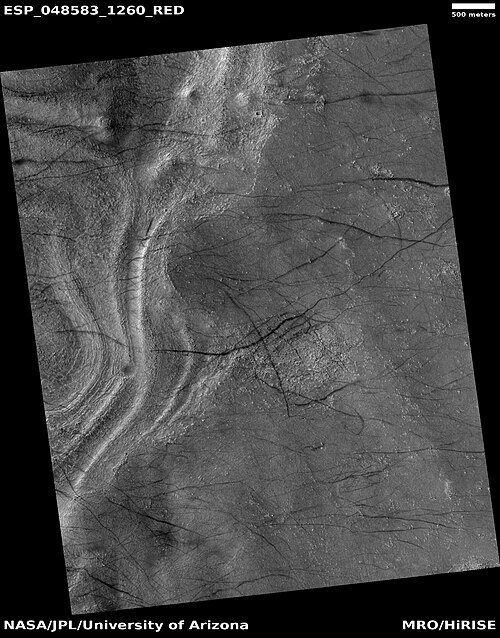
Dust devil tracks can be very pretty. They are caused by giant dust devils removing bright colored dust from the Martian surface; thereby exposing a dark layer. Dust devils on Mars have been photographed both from the ground and high overhead from orbit. They have even blown dust off the solar panels of two Rovers on Mars, thereby greatly extending their useful lifetime.[27] The pattern of the tracks has been shown to change every few months.[28] A study that combined data from the High Resolution Stereo Camera (HRSC) and the Mars Orbiter Camera (MOC) found that some large dust devils on Mars have a diameter of 700 m and last at least 26 minutes.[29]
Dunes
Other features in Argyre quadrangle

See Also
References
- ↑ Blunck, J. 1982. Mars and its Satellites. Exposition Press. Smithtown, N.Y.
- ↑ Robbins |display-authors=et al | year = 2013 | title = large impact crater histories of Mars: The effect of different model crater age techniques | url = | journal = Icarus | volume = 225 | issue = 1| pages = 173–184 | doi=10.1016/j.icarus.2013.03.019 |
- ↑ Parker, T. et al. 2000. Argyre Planitia and the Mars global hydrolocia cycle. LPSC XXXI. Abstract 2033
- ↑ Kargel, J. and R. Strom. 1991. Terrestrial glacial eskers: analogs for martian sinuous ridges. LPSC XXII, 683-684.
- ↑ Michael H. Carr|title=The surface of Mars|url=https://books.google.com/books?id=uLHlJ6sjohwC%7Caccessdate=21 March 2011|year=2006|publisher=Cambridge University Press|
- ↑ Dundas, C., S. Diniega, and A. McEwen. 2014. LONG-TERM MONITORING OF MARTIAN GULLY ACTIVITY WITH HIRISE. 45th Lunar and Planetary Science Conference. 2204.pdf
- ↑ NASA/Jet Propulsion Laboratory. "NASA orbiter finds new gully channel on Mars." ScienceDaily. ScienceDaily, 22 March 2014. www.sciencedaily.com/releases/2014/03/140322094409.htm
- ↑ http://spaceref.com/mars/frosty-gullies-on-mars.html
- ↑ Dundas, C., S. Diniega, A. McEwen. 2015. Long-term monitoring of martian gully formation and evolution with MRO/HiRISE. Icarus: 251, 244–263
- ↑ last1 = Raack | first1 = J. | display-authors = etal | year = 2015 | title = Present-day seasonal gully activity in a south polar pit (Sisyphi Cavi) on Mars| url = | journal = Icarus | volume = 251 | issue = | pages = 226–243 | doi=10.1016/j.icarus.2014.03.040 |
- ↑ last=Harrington |first=J.D. |last2=Webster |first2=Guy |title=RELEASE 14-191 – NASA Spacecraft Observes Further Evidence of Dry Ice Gullies on Mars |url=http://www.nasa.gov/press/2014/july/nasa-spacecraft-observes-further-evidence-of-dry-ice-gullies-on-mars |date=July 10, 2014 |work=NASA
- ↑ CNRS. "Gullies on Mars sculpted by dry ice rather than liquid water." ScienceDaily. ScienceDaily, 22 December 2015. www.sciencedaily.com/releases/2015/12/151222082255.htm
- ↑ http://www.skyandtelescope.com/astronomy-news/martian-gullies-triggered-by-exploding-dry-ice-122320158
- ↑ Dundas, C., S. Diniega, C. Hansen, S. Byrne, A. McEwen. 2012. Seasonal activity and morphological changes in martian gullies. Icarus, 220. 124–143.
- ↑ Edgett | first1 = Kenneth S. | journal = The Mars Journal | volume = 1 | pages = 5–58|bibcode = 2005IJMSE...1....5E }}
- ↑ Malin | first1 = M. P. | last2 = Edgett | first2 = K. S. | date = 2000 | title = Ancient sedimentary rocks of early Mars | url = | journal = Science | volume = 290 | issue = 5498| pages = 1927–1937 | doi = 10.1126/science.290.5498.1927 | pmid = 11110654 |
- ↑ Baker, V., et al. 2015. Fluvial geomorphology on Earth-like planetary surfaces: a review. Geomorphology. 245, 149–182.
- ↑ Carr, M. 1996. in Water on Mars. Oxford Univ. Press.
- ↑ Baker, V. 1982. The Channels of Mars. Univ. of Tex. Press, Austin, TX
- ↑ Baker, V., R. Strom, R., V. Gulick, J. Kargel, G. Komatsu, V. Kale. 1991. Ancient oceans, ice sheets and the hydrological cycle on Mars. Nature 352, 589–594.
- ↑ Carr, M. 1979. Formation of Martian flood features by release of water from confined aquifers. J. Geophys. Res. 84, 2995–300.
- ↑ Komar, P. 1979. Comparisons of the hydraulics of water flows in Martian outflow channels with flows of similar scale on Earth. Icarus 37, 156–181.
- ↑ http://spaceref.com/mars/how-much-water-was-needed-to-carve-valleys-on-mars.html
- ↑ Luo, W., et al. 2017. New Martian valley network volume estimate consistent with ancient ocean and warm and wet climate. Nature Communications 8. Article number: 15766 (2017). doi:10.1038/ncomms15766
- ↑ Touma J. and J. Wisdom. 1993. The Chaotic Obliquity of Mars. Science 259, 1294-1297.
- ↑ Laskar, J., A. Correia, M. Gastineau, F. Joutel, B. Levrard, and P. Robutel. 2004. Long term evolution and chaotic diffusion of the insolation quantities of Mars. Icarus 170, 343-364.
- ↑ http://marsrovers.jpl.nasa.gov/gallery/press/spirit/20070412
- ↑ http://hirise.lpl.arizona.edu/PSP_005383_1255
- ↑ Reiss, D. et al. 2011. Multitemporal observations of identical active dust devils on Mars with High Resolution Stereo Camera (HRSC) and Mars Orbiter Camera (MOC). Icarus. 215:358-369.














